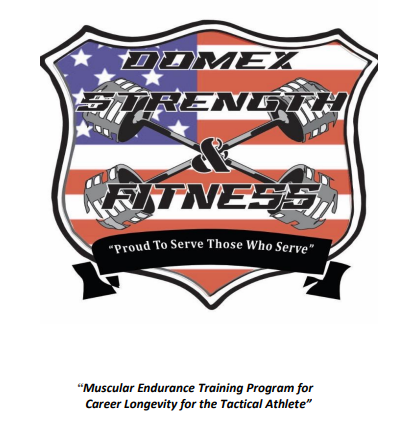Strength and Power
for the Tactical Athlete
With the DOMEX Strength & Fitness Program design

Save Time
This course provides step-by-step guidance through each DEA (PTA) chapter, ensuring you stay on the right path to pass the exam.

Save Money
Achieve cost savings by successfully passing the exam on your initial attempt.
Course Curriculum:
Course Overview:
In order for the men and women that are serving in today’s law enforcement profession to perform optimally in their assigned duties, they have to prepare themselves as “Tactical Athletes,” and a sound program design based upon strength and power is paramount. A tactical athlete is an individual that is in the law enforcement, firefighter, military or 1st responder profession that needs to possess the athletic prowess to perform optimally day in and day out within their job description. These individual’s professions are without a doubt, extremely challenging and rewarding but are encountered with a myriad of variables. No matter what the 1st Responder’s current assignment is, training as a tactical athlete will contribute to optimal performance and career longevity.
Course Description:
The program design included here is for the individual to work on their development of strength and power which is a key component for career success and career longevity. Additionally, strength and power is crucial for the tactical athlete who find themselves lifting and moving external loads or resistive forces repeated times throughout their daily jobs. Training for strength is the body’s ability to exert maximal contractions and repetitions with a certain force or object. An example would be to conduct a bench press, squat or deadlift for generally 2-6 repetitions. This repetition count correlates to an intensity of approximately 85- 97% of your One Repetition Maximum (1RM) which would be at a maximal force. Furthermore, the exact rest periods are programmed into this four week program which will keep you focused on building the physiological adaptations of strength and power. This program stresses the phosphagen (our bodies most powerful source of energy) and the glycolytic energy system. For these reasons, we have programmed ample enough rest periods between each working set for proper replenishment of your muscles energy stores to properly prepare for subsequent sets at full intensity. By engaging in this strength and power program, you will make the physiological adaptations that will improve your anaerobic metabolism which will transfer to your on demand daily tasks of strength and power.
How a tactical athlete training program prepares for functional fitness
Now that the job description and role of a ‘tactical athlete” is clearly defined, and why muscular endurance is needed for the tactical athlete, then how does an individual train like a “tactical athlete?” Some of the variables that need to adhered to when implementing a sound program design for a “tactical athlete” should be centered upon the following:
- Conducting training based upon a tactical athlete’s job description entails devising a program design for what they do through utilizing the three anatomical planes of human movement. Training this way makes the tactical operator better equipped to successfully conquer any physically demanding task they encounter. Not only does this accomplish these objectives but equally important, assists the operator in aiding them in preventing Musculoskeletal (MSK) injuries. The three anatomical planes of human movement are the following:
- (A) Saggittal plane which separates the left and right sides of the body.
- (B) Frontal plane which separates the anterior and posterior of the body.
- (C) Transverse plane which separates the upper (superior) and lower (inferior) halves of the body

“Tactical athlete” training through all 3 anatomical planes of human movement.
The following is a brief list of how a “tactical athlete” should center their training upon which takes into account of all three anatomical planes of movement. This is not an all-inclusive list but rather a representative sample of the desired movement patterns in order to elicit optimal physical performance.
- Resistance Training Exercise Techniques – Bench press, deadlift, squat, Romanian Deadlift and several more with the purchase of the program.
- Bodyweight Exercises: Pull/Chin-ups, push-ups, planks and several more with the purchase of this program.
- Flexibility and Mobility Exercise Techniques and Programming – Mobility is affected by one’s ability to move freely through coordination and without restriction. Flexibility does not indicate the ability of movement but rather the ability for one to develop a range of motion for ones muscles, ligaments and tendons. Stability is ability to maintain control of joint movement around its axis. Types of stretching – Static, ballistic and dynamic. It should be noted that “dynamic stretching” is considered one of the premium forms of stretching to be effected before conducting an exercise session as it raises the core temperature of the body in preparation for exercise. (Further explanations of dynamic stretching with examples can be found at our IG page of @Domexstrengthandfitness and linked articles on this website.)
Strength and power modalities devised for today’s 1st Responders and tactical athletes.
The following is a program design of four workouts devised into a two-day upper and two-day lower body split to be conducted for for the physiological adaptations of strength and power through anaerobic conditioning with resistance training as the main focus. Additionally, this program adds plyometric exercises which are an essential element for today’s tactical athlete or 1st responder. Plyometrics add a specific training modality by focusing on the bodies fast twitch muscle fibers which in turn improves the body’s ability to become more powerful and explosive. Plyometrics will give the operator the real world movement techniques during exercise that will transcend to improved job performance.

